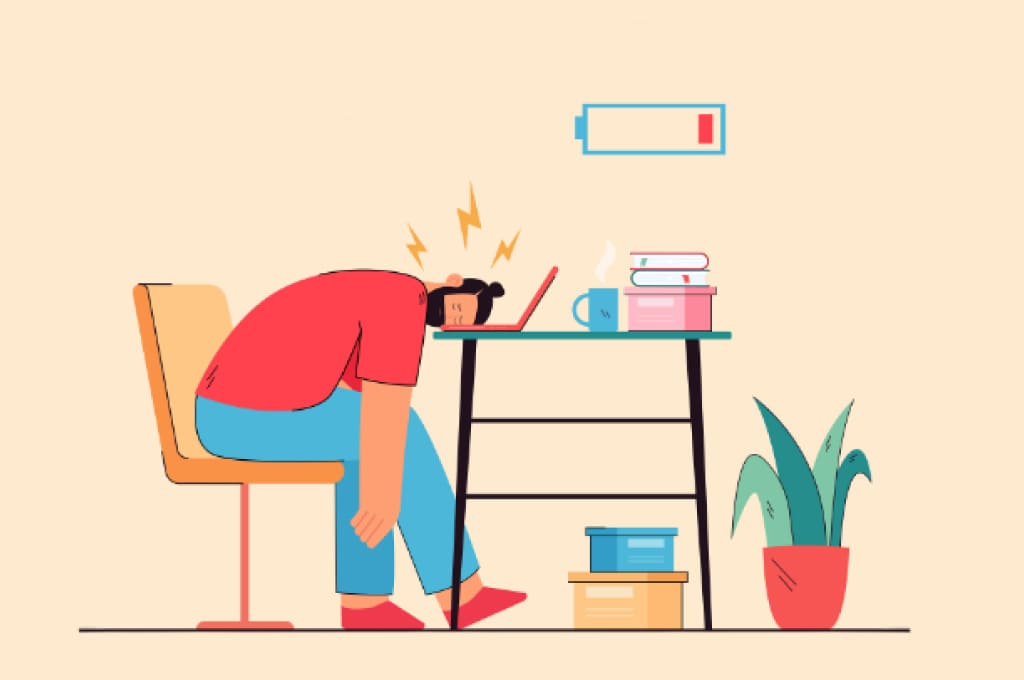According to the World Health Organization, the number of people experiencing various forms of exhaustion increases every year. Many who previously considered themselves simply fans of working 10-12 hours a day, eventually move into the category where emotional burnout becomes a real diagnosis. At the same time, professional burnout is now officially recognized as one of the main reasons for decreased productivity and increased staff turnover in companies in various fields.
How to understand that you are not on the dangerous edge and can you confidently say: "I am just working hard, and not driving myself into a dead end?" In this article, we will analyze the differences between workaholism and burnout, how to track alarm signals in time and what to do if you have already encountered a painful condition.

Workaholism or burnout
To understand why burnout prevention has become so important, it is important to clearly understand the difference between workaholism and chronic exhaustion. A burnout test usually shows how close a person is to the critical point, but does not give a complete picture of the root of the problem. Workaholism is, first of all, a constant, uncontrollable thirst for work, and work becomes an overvalued goal. As a result, personal interests, family matters and even basic needs often fade into the background.
On the other hand, burnout is a complex condition in which a person feels a complete depletion of mental and physical resources. Speaking about the symptoms of burnout, we mean not only fatigue, but also apathy, irritability, a feeling of hopelessness. If workaholism can exist in the form of "endless enthusiasm" and fanatical dedication to the cause, then burnout is characterized by a feeling of complete emptiness and a lack of strength to continue.
How to know if you're a workaholic
Many people, especially during their career growth, believe that workaholism is something of a compliment. They say that the more you work, the more successful you become. But it’s easy to lose the line here. The key sign is when you can’t stop thinking about business even in the evening, on weekends and during vacations. A workaholic can rarely calmly spend a day without gadgets and mail, he is drawn to check tasks, read business correspondence, set new priorities.
In the office, such a person almost never leaves his workplace, eats on the run and gets irritated if someone distracts him with unimportant questions. When working remotely, it’s even more difficult, since the boundaries of the working day are erased. For example, a real story from the IT sphere: a manager who worked from home deliberately avoided communicating with his family, locking himself in a separate room; even during meals, a laptop was lying nearby, and during breaks, he kept track of all new messages in messengers. This is not diligence, but an unhealthy habit that leads to exhaustion.
The dangers of workaholism
Any extreme behavior leads to consequences for mental and physical health. Often, burnout at work becomes a logical result of life in a 24-hour busy mode. At first, the body functions at high speed: adrenaline, excitement, striving for new goals. But gradually a decline in strength sets in.
Regular stress at work and lack of adequate rest increase the risk of hypertension, insomnia, cardiovascular diseases. The mental sphere also suffers: irritability is replaced by apathy, panic attacks are possible. Personal life fades into the background - a person has no time to build relationships, communicate with friends, pursue hobbies. As a result, a person loses not only health, but also emotions, the joy of the work process itself. When “only work” becomes the meaning of life, there is a high probability of losing balance and facing a crisis.
How workaholism leads to burnout
A busy schedule and obsession with work prevent you from noticing warning signs in time. Boundaries blur, and emotional burnout sets in: you feel that your love for your work has disappeared, and the work itself seems like an unbearable burden. Professional burnout can also develop at the same time, when you have no strength left to perform even familiar tasks. Workaholics are often the first to face this, as they systematically ignore the natural need for rest.
The main symptoms of burnout are chronic fatigue, loss of motivation, and sudden mood swings. Let's say you suddenly notice that every morning you have a hard time getting out of bed, and your hands literally tremble at the thought of a new workday. A feeling of guilt appears for the fact that you "can no longer" work the way you used to. In practice, it has been observed that people prone to workaholism do not take vacations for years or are afraid to delegate tasks, and as a result, at one point they “break down”: efficiency drops sharply, up to a complete refusal to function.
Burnout Test: A Quick Checklist
To understand how much you need burnout prevention, take a simple burnout test. Answer “yes” or “no” to the following questions:
- Do you regularly work more than 10 hours a day without additional pay or compensation?
- Do you feel irritated or anxious when you can't check your work email outside of work hours?
- Do you often have trouble sleeping or falling asleep because you think about work?
- Are your mood and self-esteem closely tied to your work performance?
- Do you miss family and personal events to complete your work responsibilities?
- Do you feel constantly tired and lacking energy, even when you are physically resting?
If you have three or more "yes" answers, then you are already at risk and it's time to take action. If all six are “yes,” then most likely, the symptoms of burnout are already making themselves known, and you may need the help of a specialist.
How to deal with burnout
If workaholism and the subsequent crisis have already affected your health, the first step is to recognize the problem. Many people spend months or even years trying to “break through the wall” through a state of loss of strength, but without a well-developed strategy, it is difficult to cope. If you understand that your affairs are literally slowing down, and your strength is waning, you should honestly say to yourself: “I am at the limit.”
Recovery tips:
- A workaholic must learn to plan rest as carefully as work tasks. Include time in the calendar for sports, reading, walks, meetings with friends.
- Reduce the workload, learn to delegate and do not hesitate to say “no” when a project exceeds your resources.
- Sometimes it is useful to take a break - a vacation or at least a long weekend without gadgets and prompt communication with the office.
- Analyze what exactly motivates you at work, and what, on the contrary, leads to stress. Perhaps it is worth revising your career plans.
- If necessary, contact a psychologist or psychotherapist: competent support from a specialist will help you get out of a state of burnout faster.
Real life examples and statistics
According to the European Agency for Safety and Health at Work, around 50% of workers in the EU experience burnout at some point in their career. More than 30% report stress at work as a permanent condition that prevents them from living a full life. A real-life example: in France, there was a case where an employee of a large bank took on extra shifts for years, was proud of his “irreplaceable” status, and did not even notice the first signs of discomfort. A couple of years later, he admitted that he had not seen his friends for a long time, suffered from insomnia, and could not feel the joy of results. After being hospitalized for a heart attack, it turned out that the cause was chronic stress caused by a total lack of rest.
Such stories remind us how important it is to maintain balance. Often, employers notice the “self-sacrifice” of an employee, but do not always intervene in time, considering it an expression of dedication or loyalty to the company. The result is the loss of a valuable employee whose resources have been irretrievably undermined.
Modern methods of prevention
Today, large corporations and startups are increasingly implementing programs that view emotional burnout as a management task. Constant monitoring of employees' condition, regular conversations with the manager or HR, flexible hours and support for corporate culture help prevent professional burnout from becoming the norm. Psychologists and coaches are often invited to offices, and training workshops are held on how to reduce anxiety and prevent burnout.
If management does not provide such opportunities, take the initiative into your own hands. Burnout prevention should become a habit: take breaks according to a schedule, distribute the workload and do not hesitate to talk to colleagues and management about the fact that you need more time to recover. You can use various digital time management tools: blocking some work chats in the evening, planners that help control the number of hours spent at work. Remember that if you push yourself to the limit, no one but you will be held accountable.
Conclusion
To sum it up, it is important to understand that a burnout test and a critical look at your own habits are just the first step to recognizing the symptoms of burnout in time and taking control of the situation. Work-life balance is not a myth, but a necessary condition for a fulfilling existence. Without rest, hobbies, a circle of friends and family warmth, enthusiasm fades, and even the most passionate person risks finding themselves on the verge of a breakdown.
Remember that you can maintain a clear separation between work and personal matters with the help of convenient tools. For example, if all corporate correspondence and communication with colleagues are in one channel, and your personal space remains untouched, you feel more protected from constant notifications. eXpress corporate messenger is perfect for this, as it helps to clearly distinguish between personal and work communication. The sooner you think about your priorities and learn to draw boundaries, the higher your chances of avoiding the dangerous trap of incessant work and destructive burnout.
Take care of yourself and remember that your main resource is yourself.





